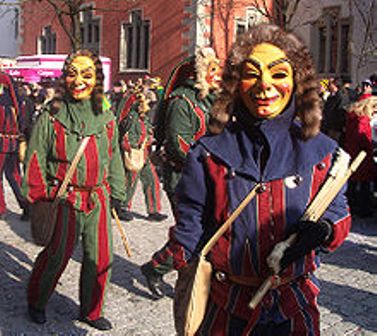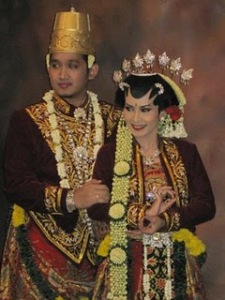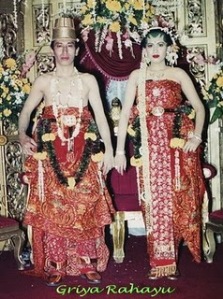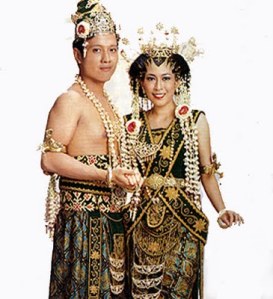From Wikipedia, the free encyclopedia
Balinese art is art of Hindu–Javanese origin that grew from the work of artisans of the Majapahit Kingdom, with their expansion to Bali in the late 13th century. From the sixteenth until the twentieth centuries, the village of Kamasan, Klungkung (East Bali), was the centre of classical Balinese art. During the first part of the twentieth century, new varieties of Balinese art developed. Since the late twentieth century, Ubud and its neighboring villages established a reputation as the center of Balinese art. Ubud and Batuan are known for their paintings, Mas for their woodcarvings, Celuk for gold and silver smiths, and Batubulan for their stone carvings. Covarrubiasdescribes Balinese art as, “… a highly developed, although informal Baroque folk art that combines the peasant liveliness with the refinement of classicism of Hinduistic Java, but free of the conservative prejudice and with a new vitality fired by the exuberance of the demonic spirit of the tropical primitive.” Eiseman correctly pointed out that Balinese art is actually carved, painted, woven, and prepared into objects intended for everyday use rather than asobject d ‘art.
Prior to 1920s, Balinese traditional paintings were restricted to what is now known as the Kamasan or Wayang style. It is a visual narrative of Hindu-Javanese epics: the Ramayana and Mahabharata, as well as a number of indigenous stories, such as the Panji narrative. These two-dimensional drawings are traditionally drawn on cloth or bark paper (Ulantaga paper) with natural dyes. The coloring is limited to available natural dyes: red, ochre, black, etc. In addition, the rendering of the figures and ornamentations must follow strictly prescribed rules, since they are mostly produced for religious articles and temple hangings. These paintings are produced collaboratively, and therefore mostly anonymously.
There were many experiments with new types of art by Balinese from the late nineteenth century onwards. These experiments were stimulated by access to new materials (western paper and imported inks and paint), and by the 1930s, new tourist markets stimulated many young Balinese to be involved in new types of art.
In the 1920s, with the arrival of many western artists, Bali became an artist enclave (as Tahiti was for Paul Gauguin) for avant-garde artists such as Walter Spies (German), Rudolf Bonnet (Dutch), Adrien-Jean Le Mayeur (Belgian), Arie Smit (Dutch) and Donald Friend (Australian) in more recent years. Most of these western artists had very little influence on the Balinese until the post-World War Two period, although some accounts over-emphasise the western presence at the expense of recognising Balinese creativity.
On his first visit to Bali in 1930, the Mexican artist Miguel Covarrubias noted that local paintings served primarily religious or ceremonial functions. They were used as decorative cloths to be hung in temples and important houses, or as calendars to determine children’s horoscopes. Yet within a few years, he found the art form had undergone a “liberating revolution.” Where they had once been severely restricted by subject (mainly episodes from Hindu mythology) and style, Balinese artists began to produce scenes from rural life. These painters had developed increasing individuality.
This groundbreaking period of creativity reached a peak in the late 1930s. A stream of famous visitors, including Charlie Chaplin and theanthropologists Gregory Bateson and Margaret Mead, encouraged the talented locals to create highly original works. During their stay in Bali in mid 1930s, Bateson and Mead collected over 2000 paintings, predominantly from the village of Batuan, but also from the coastal village of Sanur. Among western artists, Spies and Bonnet are often credited for the modernization of traditional Balinese paintings. From the 1950s onwards Baliese artists incorporated aspects of perspective and anatomy from these artists. More importantly, they acted as agents of change by encouraging experimentation, and promoted departures from tradition. The result was an explosion of individual expression that increased the rate of change in Balinese art. The 1930s styles were consolidated in the 1950s, and in more recent years have been given the confusing title of “modern traditional Balinese painting”. The Ubud painters, although a minority amongst the artists working in the 1930s, became the representatives of the new style thanks to the presence of the great artist Gusti Nyoman Lempad in that village, and to the patronage of the traditional rulers of Ubud. The key points of the Ubud Style included a concentration on the depiction of daily Bali life and drama; the change of the patron of these artists from the religious temples and royal houses to western tourists/collectors; shifting the picture composition from multiple to single focus. Despite the adoption of modern western painting traditions by many Balinese and Indonesianpainters, “modern traditional Balinese painting” is still thriving and continues by descendants/students of the artists of the pre-war modernist era (1928-1942). The schools of modern traditional Balinese painting include: Ubud, Batuan, Sanur, Young Artist and Keliki schools of painting.
Modern traditional painting
The pre-War modernisation of Bainese art emanated from three villages: Ubud, where Spies settled, Sanur on the southern coast, and Batuan, a traditional hub of musicians, dancers, carvers and painters. The artists painted mostly on paper, though canvas and board were also used. Often, the works featured repetitive clusters of stylized foliage or waves that conveyed a sense of texture, even perspective. Each village evolved a style of its own. Ubud artists made more use of open spaces and emphasized human figures. Sanur paintings often featured erotic scenes and animals, and work from Batuan was less colorful but tended to be busier.
Ubud painting

Mask Dancer, A.A. Gde Anom Sukawati (b. 1966), Acrylic on canvas
Ubud has been the center of art for centuries, with the surrounding royal houses and temples as the main patrons. Prior to the 1920s, traditional wayang style paintings dominated the subject matters, although Jean Couteau believes that both secular and religious theme paintings have long been co-existing in the form of the expression of the unity of opposites (Rwabhinneda in Balinese belief system).
Under the patronage of the Ubud royal family, esepcially Tjokorda Gde Agung Sukawati, and with Rudolf Bonnet as a chief consultant, the Pitamaha Art Guild was founded in 1936 as a way to professionalise Balinese painting. Its mission was to preserve the quality of Balinese Art in the rush of tourism to Bali. The board members of Pitamaha met regularly to select paintings submitted by its members, and to conduct exhibitions throughout Indonesia and abroad. Pitamaha was active until the beginning of the second world war in 1942.The subject matters shifted from religious narration to Balinese daily life. Ubud artists who were members to Pitamaha came from Ubud and its surrounding villages; Pengosekan, Peliatan and Tebasaya. Among them were: Ida Bagus Made Kembeng of the village of Tebesaya and his three sons Ida Bagus Wiri, Ida Bagus Made and Ida Bagus Belawa; Tjokorda Oka of the royal house of Peliatan; Anak Agung Gde Sobrat, Anak Agung Gde Meregeg, I Dewa Putu Bedil, I Dewa Nyoman Leper, Anak Agung Dana of Padangtegal; I Gusti Ketut Kobot, I Gusti Made Baret, I Wayan Gedot, Dewa Putu Mokoh of Pengosekan; and I Gusti Nyoman Lempad. Artists from other areas also participated, including Pan Seken from Kamasan, I Gusti Made Deblog from Denpasar, and some of the Sanur artists.
Pitamaha has been by the descendents of the Ubud artists, and has now come to be identified with the period of the 1930s. Noted Ubudian artists include I Ketut Budiana, I Nyoman Meja, I Nyoman Kayun, A.A. Gde Anom Sukawati, I Gusti Agung Wiranata, and Ida Bagus Sena
Batuan painting
The Batuan school of painting is practiced by artists in the village of Batuan, which is situated ten kilometers to the South of Ubud. The Batuan artisans are gifted dancers, sculptors and painters. Leading artists of the 1930s included I Nyoman Ngendon, and a number of members of leading brahman families, including Ida Bagus Made Togog. Other major Batuan artists from the pre-modernist era include I Dewa Nyoman Mura (1877-1950) and I Dewa Putu Kebes (1874-1962), who were known as sanging; traditional Wayang-style painters for temples’ ceremonial textiles.
The western influence in Batuan did not reach the intensity it had in Ubud. According to Claire Holt, the Batuan paintings were often dark, crowded representations of either legendary scenes or themes from daily life, but they portrayed above all fearsome nocturnal moments when grotesque spooks, freakish animal monsters, and witches accosted people. This is particularly true for paintings collected by Margaret Mead and Gregory Bateson during their field studies in Bali in 1936 to 1939.Gradations of black to white ink washes laid over most of the surface, so as to create an atmosphere of darkness and gloom. In the later years, the designs covered the entire space, which often contributed to the crowded nature of these paintings.

The Wheel of Life, I Ketut Murtika (b. 1952), Gouache on canvas
Among the early Batuan artists, I Ngendon (1903-1946) was considered the most innovative Batuan School painter.[4] Ngendon was not only a good painter, but a shrewd business man and political activist. He encouraged and mobilized his neighbours and friends to paint for tourist consumption. His ability in portraiture played an important role in teaching his fellow villagers in Batuan more than Spies and Bonnet.The major Batuan artists from this period were: I Patera (1900-1935), I Tombos (b. 1917), Ida Bagus Togog (1913-1989), Ida Bagus Made Jatasura (1917-1946), Ida Bagus Ketut Diding (1914-1990), I Made Djata (1920-2001), and Ida Bagus Widja (1912-1992). The spirit of the Pitamaha period is still strong and continues by contemporary Batuan Artists such as I Made Budi , I Wayan Bendi (b. 1950), I Ketut Murtika (b. 1952), I Made Sujendra (b. 1964), and many others. I Made Budi and I Wayan Bendi paintings capture the influence of tourism in modern life in Bali. They place tourists with their camera, riding a motorbike or surfing in the midst of Balinese traditional village activities. The dichotomy of modern and traditional Balinese life are contrasted starkly in harmony. I Ketut Murtika ( still paints the traditional story of Mahabharata and Ramayana in a painstaking details with subdued colors. His painting of the Wheel of Life viewed from the Balinese beliefs system shows his mastery of local legends and painstaking attention to details. I Made Sujendra, an art teacher at a local art school, depicts old Balinese folklore with a modern eye and a high degree of individuality. Rejecting excessive decoration and relying on the composition itself, I Made Sujendra is successful in depicting tensions in his work and the old Batuan style of 1930s.
Sanur painting
Unlike Ubud and Batuan which are located in the inland of Bali, Sanur is a beach resort. Sanur was the home of the well known Belgian artist Le Mayeur de Mepres, who lived with a Balinese wife (Ni Polok) and had a beach house in Sanur beach.
Tourists in 1930s came to Bali on cruise ships docked in Sanur and made side trips to Ubud and neighboring tourist sites. Its prime location provided the Sanur artist with ready-access to Western tourists who frequented the shop of the Neuhaus Brothers who sold balinese souvenirs and tropical fishes. Neuhaus brothers became the major art dealer of Sanur paintings. The beach around Sanur, full of outriggers and open horizon, provided local artists with a visual environment different from the Ubud and Batuan, which are located in the hinterland.The playful atmosphere pervades the Sanur paintings, and are not dictated by the religious iconography[5]. It is lighter and airy than those of Batuan and Ubud with sea creatures, erotic scenery and wild animals drawn in rhythmic patterns; often in an Escher-like manner.Most early works were black and white ink wash on paper, but at the request of Neuhaus, latter works were adorned with light pastel colors often added by other artists specializing in coloring a black and white drawings. Their name code is often found at the margin.
The Sanur school of painting is the most stylized and decorative among all modern Balinese Art. Major artists from Sanur are I Rundu, Ida Bagus Nyoman Rai, I Soekaria, I Poegoeg, I Rudin, and many others. I Rudin, who started to paint in mid 1930s, draws simple balinese dancers in the manner of the drawings of Miguel Covarrubias.
Young Artist painting
The development of the Young Artist School of painting is attributed to the Dutch artist Arie Smit, a Dutch soldier who served during the 2nd world war and decided to stay in Bali. In the early 1960s, he came across children in the village of Penestanan near Tjampuhan drawing on the sand. He encouraged these children to paint by providing them with paper and paints.
Their paintings are characterized by “child-like” drawings that lacks details and bright colors drawn with oil paint on canvas. By 1970s, it attracted around three hundred peasant painters to produce paintings for tourists. In 1983, the National Gallery of Malaysia held a major exhibition on the Young Artist paintings from the collection of Datuk Lim Chong Kit.

The snake tree, I Wayan Pugur, Gouache on paper
The painting by I Wayan Pugur (b. 1945) shown here, was executed when he was 13 years old and was exhibited at the San Francisco Museum of Modern Art in 1964, as part of a traveling exhibition in the United States in 1964-1965. This early drawing, executed on paper, exhibits the use of bright colors and a balanced composition. The drawing space is divided into three solid-color areas: dark blue, bright yellow and magenta in between showing the influence of the Wayang painting tradition. The leaves of the large tree with the snakes show the juxtaposition of complementary colors. The faces of the figures were drawn with no details, yet the snakes have eyes and long tongues.
Major artists from the Young Artist School are I Wayan Pugur, I Ketut Soki, I Ngurah KK, I Nyoman Londo, I Ketut Tagen, I Nyoman Cakra, Ni Ketut Gampil, I Nyoman Mundik, I Wayan Regog and many others.
tKeliki miniature painting

Rajapala, I Lunga, Watercolor on paper
In the 1970s, miniature paintings emerged from Keliki, a small village north of Ubud, led by a local farmer I Ketut Sana.[6] The sizes range from as small as 2 x 3 inch to as large as 10 x 15 in. I Ketut Sana learnt to paint from I Gusti Nyoman Sudara Lempad from Ubud and from I Wayan Rajin from Batuan. He combined the line drawing of Lempad and the details of the Batuan school. Every inch of the space is covered with minute details of Balinese village life and legends drawn in ink and colored with watercolor. The outcome is a marriage between the youthfulness of the Ubud school and the details of the Batuan School. The Keliki artists proud with their patience to paint minute details of every objects meticulously that occupy the drawing space.
Illustrated on the left is a drawing by I Lunga (c. 1995) depicting the story of Rajapala. Rajapala is often referred to as the first Balinese voyeur or “peeping Tom.” According to the story, Rajapala catches sight of a group of celestial nymphs bathing in a pool. He approaches stealthily, and without their knowledge, steals the skirt (kamben) of the prettiest, Sulaish. As her clothing contains magical powers enabling her to fly, the nymph cannot return home. Rajapala offers to marry her. She accepts on the condition that she will return to heaven after the birth of a child. With time, she and Rajapala have a healthy young son. Years pass, and one day, Sulaish accidentally discovers her clothing hidden in the kitchen. Understanding that she has been tricked, she takes leave of her husband and son and goes back to her heavenly abode.
Major artists from the Keliki Artist School are Sang Ketut Mandera (Dolit) I Ketut Sana, I Wayan Surana, I Lunga, I Wayan Nengah, I Made Ocen, I Made Widi, I Wayan Lanus, Ida Bagus Putra, Sang Nyoman Kardiana (Sabuh) and many others.
Wood carving

Woodcarving of an elderly Balinese lady (art deco style), c. 1930s
Like the Balinese painting, Balinese wood carving underwent a similar transformation during the 1930s and 1940s. The creative outburst emerged during this transition period is often attributed to western influences. In 2006, an exhibition at the Nusantara Museum, Delft, the Netherlands Leidelmeijer traced the Art Deco influence on Balinese wood carving. Leidelmeijer further conjectured that the Art Deco influence continued well into 1970s.
During the transition years, the Pitamaha Artist Guild was the prime mover not only for Balinese paintings, but also for the development of modern Balinese wood carvings. I Tagelan (1902-1935) produced an elongated carving of a Balinese woman from a long piece of wood that was given by Walter Spies, who originally requested him to produce two statues. This carving is in the collection of the Puri Lukisan Museum in Ubud.

Dewi Gadru by Ida Bagus Tilem, c. 1950s
Other masters of Balinese modernist woodcarving were: Ida Bagus Nyana, Tjokot (1886-1971)and Ida Bagus Tilem.
Ida Bagus Nyana was known for experimenting with mass in sculpture. When carving human characters, he shortened some parts of the body and lengthened others, thus bringing an eerie, surreal quality to his work. At the same time he didn’t overwork the wood and adopted simple, naive themes of daily life. He thus avoided the “baroque” trap, unlike many carvers of his day.
Tjokot gained a reputation for exploiting the expressive quality inherent in the wood. He would go into the forest to look for strangely shaped trunks and branches and, changing them as little as possible, transforming them into gnarled spooks and demonic figures.
Ida Bagus Tilem, the son of Nyana, furthered Nyana and Tjokot’s innovations both in his working of the wood and in his choice of themes. Unlike the sculptors from the previous generation, he was daring enough to alter the proportions of the characters depicted in his carving. He allowed the natural deformations in the wood to guide the form of his carving, using gnarled logs well suited for representing twisted human bodies. He saw each deformed log or branch as a medium for expressing human feelings. Instead of depicting myths or scenes of daily life, Tilem took up “abstract” themes with philosophical or psychological content: using distorted pieces of wood that are endowed with strong expressive powers. Ida Bagus Tilem, however, was not only an artist, but also a teacher. He trained dozens of young sculptors from the area around the village of Mas. He taught them how to select wood for its expressive power, and how to establish dialogue between wood and Man that has become the mainstream of today’s Balinese woodcarving.
Museums holding important Balinese painting collection
There are many museums throughout the world holding a significant collection of Balinese paintings.
- Europe: In the Netherlands, the Tropenmuseum in Amsterdam and the Ethnographic Museum in Leiden, Museum Nusantara in Delft have a large number of paintings from the Wayang period (before 1920s) and the pre-War period (1920s – 1950s). Notably, the Leiden Ethnographic Museum holds the Rudolf Bonnet and Paul Spies collection. In Switzerland, the Ethnographic Museum in Basel holds the pre-War Batuan and Sanur paintings collected by Schlager and the artist Theo Meier.
- Asia: In Japan, the Asian Art Museum in Fukuoka holds an excellent Balinese collection after the Second World War. The Singapore National Art Museum has significant collection of pre-War and post-War Balinese paintings.
- Australia: The Australian Museum, Sydney, has a major collection of Kamasan and other traditional paintings assembled by the Anthropologist Anthony Forge. The National Gallery of Australia in Sydney holds some Balinese works.
- Indonesia: the Museum Sana Budaya in Yogyakarta and Museum Bentara Budaya in Jakarta. In Bali, pre-war Balinese drawings are at the holdings of the Bali Museum in Denpasar and Center for Documentation of Balinese Culture in Denpasar. In addition, there are four major museums in Ubud, Bali, with significant collections: Museum Puri Lukisan, Agung Rai Museum of Art, Neka Museum and Museum Rudana.
- America: Duke University Museum in Durham, American Museum of Natural History in New York, United Nations in New York.


































 Karo, North Sumatera
Karo, North Sumatera Nias, North Sumatera
Nias, North Sumatera











































































 Topeng Kelana
Topeng Kelana










































































 Merry’s reception the truly international flavor of the event led to speeches in Bahasa Indonesia, German, English, and of course the Batak Karo dialect.
Merry’s reception the truly international flavor of the event led to speeches in Bahasa Indonesia, German, English, and of course the Batak Karo dialect.






 A
A  Aztec mask of
Aztec mask of
 Various
Various  In China masks are thought to have originated in ancient religious ceremonies. Images of people wearing masks have been found in rock paintings along the
In China masks are thought to have originated in ancient religious ceremonies. Images of people wearing masks have been found in rock paintings along the  Golden masks excavated in Kalmakareh,
Golden masks excavated in Kalmakareh, Fools Meeting or Parade,
Fools Meeting or Parade,  Puppets found in the
Puppets found in the 
 Protective masks are pieces of kit or equipment worn on the head and face to afford protection to the wearer, and today usually have these functions:
Protective masks are pieces of kit or equipment worn on the head and face to afford protection to the wearer, and today usually have these functions:



























































































































































